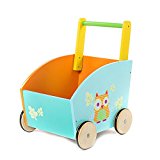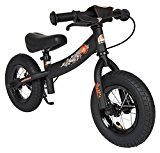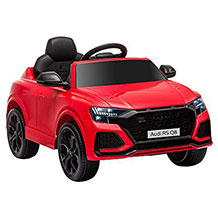Balance bike purchasing advice: how to choose the right product
- What You Need to Know
- Balance bikes have no pedals. Children simply push off the ground with their feet.
- Balance bikes are ideal for teaching your child to ride a bike. The child develops a much better sense of balance than with training wheels.
- The purchase of a balance bike is recommended from the age of two at the earliest.
- Metal models are robust and weatherproof.
- Balance bikes with adjustable saddles and handlebars will accompany your child for several years.
Fun while learning
For many, learning to ride a bike was once abrupt and painful: parents put the child on the bike and held him or her by the saddle while riding. At some point, one wondered why they were suddenly so quiet. You turned around and the parents waved from a distance. Already one had mastered the first ride alone – and usually shortly afterwards also the first fall.
Nowadays, a simpler option is common for toddlers to get used to riding a bike: balance bikes. These are small bicycles without pedals or a chain. Instead, children push themselves off the ground with their feet. By stabilising themselves with their feet, they can stay upright even without training wheels. Simple balance bikes consist only of a bicycle frame, handlebars, a saddle and two wheels.

Better than tricycles and training wheels
Unlike tricycles and bicycles with training wheels, balance bikes help children develop their sense of balance. They gain confidence in moving around on two wheels, which makes future cycling much easier. Particularly brave children may reach a higher speed, which means that parents have to run behind them more.
Most importantly, unlike with tricycles and training wheels, children learn to steer correctly. With training wheels, children just turn the steering wheel. Without the balance aid, however, this strategy leads to a fall. Children must learn to steer by shifting their weight. This is only possible with balance bikes.
Pro points
- Promotes balance
- Correct steering can be learned
- Can be used from the age of two
- Fun factor
Drawbacks
- May be somewhat strenuous for parents
The best manufacturing material
Balance bikes are made of metal, wood or plastic. Metal balance bikes are sometimes also covered with plastic, which helps manufacturers keep the weight as low as possible. There is hardly any price difference between metal and wood, the usual materials of manufacture. Plastic wheels, on the other hand, are usually a little cheaper.
Metal
The most common balance bikes are made of metal, steel to be precise. Therefore, this material offers the widest choice. Metal is robust, durable and very weather-resistant. However, the weight of metal wheels is often somewhat higher, which makes them more difficult to handle for small children. Models made of the lighter aluminium are better in this respect. Almost all metal models also have adjustable saddles and handlebars. For this reason, children can ride the balance bike for several years, even as they grow. Metal balance bikes are also extremely easy to care for. However, the wheels of such models are often equipped with spokes. Spokes increase the risk of injury because children can get their feet caught in them.
Pro points
- Wide choice
- Robust
- Durable
- Weatherproof
- Adjustable saddle and handlebar
- Easy to clean
Drawbacks
- Risk of injury from spokes
- Heavy if necessary
Wood
Wood is the most sustainable manufacturing material for balance bikes, both in terms of production and disposal. Wooden wheels are often lighter than metal versions. However, there is a lot more to consider: On most models, only the saddle is adjustable, not the handlebars. Although the need for maintenance is limited, it is not as low as with metal. For example, the bike has to be dried after a damp cleaning. This already points to the biggest shortcoming of wood, namely its lack of weather resistance. A wooden wheel that is exposed to rain, snow or other weather conditions for a long time quickly becomes unusable, even if it is painted.
Pro points
- Sustainable
- Relatively light
- Adjustable saddle
Drawbacks
- Requires more maintenance than metal
- Not weatherproof
- Usually no adjustable handlebars
Plastic
Balance bikes made entirely of plastic are rare. They are mainly suitable for children who are starting to ride at a very young age. The material is extremely light, which is good for handling. Although models made of plastic are usually relatively inexpensive, the material is not very sustainable, which is a major drawback for balance bikes, as children grow out of balance bikes in just a few years. In addition, plastic is not as robust and load-bearing as wood or metal.
Pro points
- Lightweight
- Inexpensive
Drawbacks
- Not very sustainable
- Not particularly robust or strong
Safety first
At a young age, children are not exactly cautious. That’s why safety is the be-all and end-all when driving. After all, your offspring should not injure themselves. There are two safety aspects to consider: the place where the children practice and the balance bike itself.
Under no circumstances should you practise riding near a busy road. Children on balance bikes can be surprisingly fast. For example, if you practise on the pavement, the child may run into the road before you have time to react. Pedestrian zones, playgrounds or your own fenced-in property are more suitable. To prevent injury, your child should never ride without a helmet, sturdy shoes and knee and elbow pads. Sooner or later, a fall will occur during practice.

Ideally, the balance bike should be labelled with a TÜV and GS seal, which indicates a high-quality product that is free of harmful substances. Also make sure that the wheel does not pose any pinch hazards, such as spokes. Of course, the handles and saddle should also be free of harmful substances, as they will be in contact with the child for a long time. Certain pollutants can even enter the body through the skin.
With larger models for older children, a brake makes sense, but toddlers cannot operate it with their tiny hands. Opinions differ on the steering angle limitation. Some think it improves safety because children can’t steer as hard, which usually leads to a fall when driving. On the other hand, other users claim that handlebars without a steering angle limiter behave better in the event of a fall.
Other purchase criteria
In addition to safety and material, other factors such as the various features play an important role. You also have to think about size and weight. Most important, however, is the handling.
Handling
Before the child even gets to ride, he or she has to get on the balance bike. This is not always easy with models that have a high frame. This also proved to be an important feature in the Stiftung Warentest test. A low frame makes it much easier to get on.
Furthermore, children like to turn on the spot, which is not possible with a steering lock. Although this assists with riding, children can hardly be told how to use the bike.

Another important feature is the distance between the saddle and the handlebars. The greater this is, the further children have to lean forward when riding. For some, this can be a barrier to entry, as they may feel insecure when leaning forward. It is best to put the child on the balance bike before buying it to see if they are comfortable on it.
Not all bicycles are equipped with a running board. It is either designed as one wide surface in the middle of the frame or as two narrow surfaces on the sides. This means that children do not have to hold their legs up when riding, but can simply place them briefly on the footboard. If the running boards are on the sides, however, you should make sure that they do not interfere with riding. If the two footboards are too wide, your child will not be able to push itself off the ground in the best possible way.
Size, weight and load capacity
Manufacturers’ size specifications vary. Sometimes the overall height is given, but often the saddle height is the more important specification. If the saddle is height-adjustable, the maximum and minimum heights are given. Different models can reach from 25 to about 50 centimetres. It is advisable to buy a bike where the minimum height of the saddle corresponds to the height of your child’s hips. This way, the balance bike can grow a few centimetres with your child. It is important that your offspring place their whole foot on the ground with their knees slightly bent. Only in this way is it possible to push off properly.

The balance bike should be as light as possible. For small children, even a few hundred grams make a big difference. As a rule, balance bikes weigh between 2.5 and 5.0 kilograms. It is best to let the child decide for themselves whether the bike is too heavy. If you order it online, it is usually possible to return it. If in doubt, you can order two or three models and keep only one.
Balance bikes can usually carry 20 to 30 kilograms. Small children rarely weigh that much, so this figure is usually not too important. However, if the bike is going to be used beyond the usual age, you should go for a model with a higher load-bearing capacity to be on the safe side.
Adjustability
The height adjustability of the saddle and handlebars is particularly important. Children grow quickly and you don’t want to buy a new balance bike every year. With an adjustable saddle and handlebars, the bike can be used for longer until the child outgrows the age of the wheel. The saddle is usually adjustable by 10 to 15 centimetres.
Wheels
The wheels of balance bikes can have a diameter of 8 to 14 inches (20.32 to 35.56 centimetres) and have a strong effect on the size of the balance bike. In addition, balance bikes with large wheels run more smoothly because they roll over uneven ground more easily. The thicker the tyre, the safer the ride.
However, the type of tyre is particularly important for the riding experience. Tyres are either made entirely of plastic or they are pneumatic tyres made of rubber. With plastic tyres, you do not have to fear a puncture. However, they are only suitable for flat surfaces, as they hardly cushion at all. This is not the case with pneumatic tyres. Children can use them without any problems even on uneven surfaces. However, Stiftung Warentest often found harmful substances in pneumatic tyres made of rubber. Models with the GS seal should be largely free of harmful substances.
Design
Children attach great importance to the aesthetics of their balance bike. Brightly coloured frames are particularly popular. This aspect should not be underestimated. An appealing design with beautiful colours and patterns makes your child look forward to riding more and, if necessary, reach for the balance bike more often. It is best to let your child choose the design themselves. You can also show your child product pictures online before buying and let them decide for themselves.
Extras
Some balance bikes have a very simple design: Only the frame, handlebars, saddle and wheels are enough to ride on. Extras such as a footboard or a brake bring the riding experience a little closer to cycling. The children can lift their legs and brake at the same time. However, this is not possible for all age groups. Very young children cannot yet ride a balance bike without supporting themselves on the ground. In addition, their hands are often still too small to operate a brake.
Other accessories are less useful. A bell, for example, is more of a nuisance. Small children do not participate in road traffic and therefore do not need them. A side stand is also not very useful. Even if it is available, children prefer to put the wheels on the ground and straighten them up again when they want to ride.
Cleaning tips
Metal balance bikes are very easy to clean. Usually a garden hose with a little pressure is enough to get the wheel clean. If you don’t have one or the water is not enough to remove the dirt, you can use a wet rag with some detergent. It is important to clean the wheel regularly to prevent dirt from settling on it.
Wooden wheels also need to be cleaned. With such models, however, you must make sure that you do not use an aggressive cleaning agent that will damage the wood. In addition, the wheel must be dried afterwards.










 23,821 reviews
23,821 reviews




